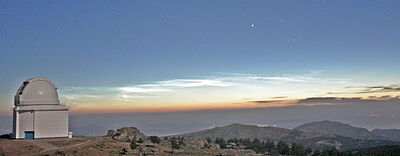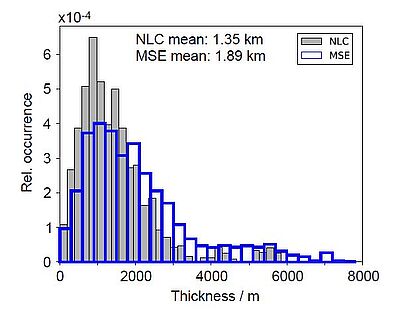Noctilucent clouds and mesospheric radar echoes
The mesopause region is so cold that the small amount of available water vapor may freeze to icy clouds. They give occasionally rise to spectacular skies and are named noctilucent clouds (also called polar mesospheric clouds). The instrumentation of the IAP is trimmed to sample these phenomena with their laser and radar systems.
The backscattered light and radio waves may be jointly interpreted to deduce the number and size of the ice crystals and their charge and composition. Although the ice particles are only 50 nm large, they can be observed in summer in 83 km height as noctilucent clouds by radar, lidar and the naked eye. Radars observe similar layers also in winter, but for these echoes the turbulent motion of charged particles is essential. As the mesopause region is a preferred place for gravity waves breakdown, we also see the imprint of these dynamical processes and it is important to reconstruct the causal relations theoretically.


Combined with model simulations the three departments jointly found out a number of features. Since 2018, from the optics, radar and modelling department emerged:
- M. Gerding, G. Baumgarten, M. Zecha, F.-J. Lübken, K. Baumgarten und R. Latteck, On the unusually bright and frequent noctilucent clouds in summer 2019 above Northern Germany, J. Atmos. Solar-Terr. Phys., 217, doi:10.1016/j.jastp.2021.105577, 2021.
- M. Gerding, J. Zöllner, M. Zecha, K. Baumgarten, J. Höffner, G. Stober und F.-J. Lübken, Simultaneous observations of NLCs and MSEs at midlatitudes: Implications for formation and advection of ice particles, Atmos. Chem. Phys., 18, 15569-15580, doi:10.5194/acp-18-15569-2018, 2018.
- M. Grygalashvyly, M. Eberhart, J. Hedin, B. Strelnikov, F.-J. Lübken, M. Rapp, S. Löhle, S. Fasoulas, M. Khaplanov, J. Gumbel und E. Vorobeva, Atmospheric band fitting coefficients derived from selfconsistent rocket-borne experiment, Atmos. Chem. Phys., 19, 1207-1220, doi:10.5194/acp-19-1207-2019, 2019.
- M. Grygalashvyly, B. Strelnikov, M. Eberhart, J. Hedin, M. Khaplanov, J. Gumbel, M. Rapp, F.-J. Lübken, S. Löhle und S. Fasoulas, Nighttime O(1D) and corresponding atmospheric band emission (762 nm) derived from rocket-borne experiment, J. Atmos. Solar-Terr. Phys., 213, doi:10.1016/j.jastp.2020.105522, 2021.
- C. Kalicinsky, D. H. W. Peters, G. Entzian, P. Knieling und V. Matthias, Observational evidence for a quasi-bidecadal oscillation in the summer mesopause region over western Europe, J. Atmos. Solar-Terr. Phys., 178, 7-16, doi:10.1016/j.jastp.2018.05.008, 2018.
- R. Latteck, T. Renkwitz und B. Strelnikov, D region observations by VHF and HF radars during a rocket campaign at Andøya dedicated to investigations of PMWE, Adv. Radio Sci., 17, 225-237, doi:10.5194/ars-17-225-2019, 2019.
- B. Strelnikov, M. Eberhart, M. Friedrich, J. Hedin, M. Khaplanov, G. Baumgarten, B. P. Williams, T. Staszak, H. Asmus, I. Strelnikova, R. Latteck, M. Grygalashvyly, F.-J. Lübken, J. Höffner, R. Wörl, J. Gumbel, S. Löhle, S. Fasoulas, M. Rapp, A. Barjatya, M. J. Taylor und P.-D. Pautet, Simultaneous in situ measurements of small-scale structures in neutral, plasma, and atomic oxygen densities during the WADIS sounding rocket project, Atmos. Chem. Phys., 19, doi:10.5194/acp-19-1-2019, 2019.
- H. Wilms, M. Rapp und A. Kirsch, Reply to comment on: "Nucleation of mesospheric cloud particles: Sensitivities and limits", J. Geophys. Res., doi:10.1029/2018JA025876, 2019.












